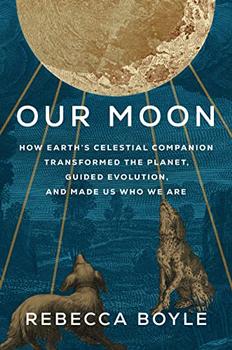Summary | Excerpt | Reviews | Beyond the Book | Read-Alikes | Genres & Themes | Author Bio

How Earth's Celestial Companion Transformed the Planet, Guided Evolution, and Made Us Who We Are
by Rebecca BoyleThis article relates to Our Moon
 When you look at the Moon, what do you see? Since ancient times, the Moon has ignited our imaginations, as Rebecca Boyle demonstrates in her history of Earth's relationship to its closest neighbor. In mythologies and legends, it has been seen as a canvas depicting a rabbit and a jovial man's features, among other things. It has been with us since the beginning, so of course we crafted its likeness as soon as we were able. Through the ages, human art related to the Moon has helped us understand our celestial companion as well as each other.
When you look at the Moon, what do you see? Since ancient times, the Moon has ignited our imaginations, as Rebecca Boyle demonstrates in her history of Earth's relationship to its closest neighbor. In mythologies and legends, it has been seen as a canvas depicting a rabbit and a jovial man's features, among other things. It has been with us since the beginning, so of course we crafted its likeness as soon as we were able. Through the ages, human art related to the Moon has helped us understand our celestial companion as well as each other.
An early example is the Nebra Sky Disk, circa 1800-1600 BCE. A stunning piece of copper and bronze with an image depicting the Moon, sun, and "Seven Sisters" constellation, it "displays the world's earliest known concrete representation of astronomical phenomena," according to archaeologists. It was created with precise, careful skill and may have been used for agricultural time-keeping.
The last Babylonian king, Nabonidus, was another subject of Moon art. Carved into a basalt stela, he is depicted with the winged disk of a Sun god and the crescent of a Moon god. His daughter, Ennigaldi-Nanna, founded the first public museum circa 530 BCE. In Our Moon, Boyle explains, "The relics tell a profound story of the Moon God and those devoted to him."
In 1609, the Moon was sketched by two very different scientists: first Thomas Harriot, then Galileo Galilei a few months later. Both were studying the Moon through their telescopes, rendering what they saw onto paper. Through their efforts, we began to realize how similar in makeup the Moon is to Earth.
In the late 1800s, the Moon was the prime subject of Tsukioka Yoshitoshi's series of 100 ukiyo-e (Japanese color woodblock prints). The Royal Museums Greenwich describes them as "an ode to the Moon and its phases," explaining that "Yoshitoshi used the lunar cycle to represent feelings like introspection, loneliness or sorrow." Other visual artists of the era who captured the moon's likeness include Vincent Van Gogh (Starry Night, 1889 and White House at Night, 1890), Henri Rousseau (A Carnival Evening, 1886), and American Modernist Albert Pinkham Ryder (Moonlight Marine, circa 1870-90).
The fourth person to walk on the Moon, Alan Bean, became a full-time painter after his 1969 visit to the lunar surface. He spent his career attempting to recapture the experience on canvas, mimicking the Moon's rocky texture and the colors we are unable to see down on Earth: various rich shades of golden orange, violet, and rosy pink. Boyle notes, "Many astronauts had described the vivid colors of the Moon, but Bean was the only one to dedicate his remaining years to rendering them for the rest of us."
The second Moon landing mission, Apollo 12, brought with it a tiny work of art: a 1.4 x 1.9 cm tall ceramic rectangle entitled The Moon Museum, featuring doodles from six artists, including Andy Warhol. The tile was left behind on the Moon along with some of the astronauts' personal items.
Luminous and mysterious, the orb of our Moon continues to intrigue and enchant, inspiring all forms of artistic expression. With its reliable, tangible presence, it may remind us of our solitary state in the galaxy, but it continues to foster human connection here on Earth.
Carnival Evening by Henri Rousseau circa 1870-1890, courtesy of Wikimedia Commons PDM 1.0 DEED
Filed under Cultural Curiosities
![]() This article relates to Our Moon.
It first ran in the February 21, 2024
issue of BookBrowse Recommends.
This article relates to Our Moon.
It first ran in the February 21, 2024
issue of BookBrowse Recommends.
Your guide toexceptional books
BookBrowse seeks out and recommends the best in contemporary fiction and nonfiction—books that not only engage and entertain but also deepen our understanding of ourselves and the world around us.